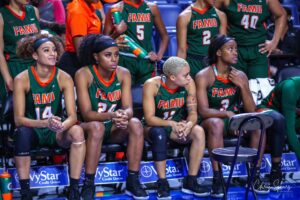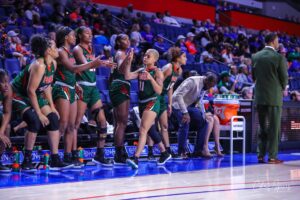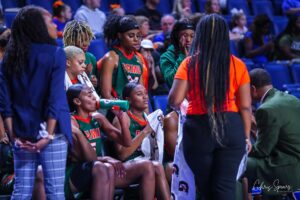
Florida StateUniversity’s women’s soccer team captured the NCAA national championship in 2018, Florida A&M’s women’s cross-country team also has enjoyed howling success, winning 10 consecutive conference championships from 2009 to 2018.
Chances are you weren’t aware of these accomplishments because there is little to no media coverage for women’s sports.
Title IX of the Education Amendments of 1972 is a federal law that was enacted to ensure that female athletes have equal access to intercollegiate athletics in educational institutions that receive financial assistance. But it doesn’t guarantee equal treatment by the media. Many femalestudent-athletes feel generally ignored by most media outlets.
“I think on all levels men get more support because a lot of people find men’s basketball more entertaining,” says Kailya Jackson, a junior guard and forward for FAMU’s women’s basketball team.
Jackson says that while most sports fans would vote to view a men’s basketball game due to the impressive athleticism on display, women’s games are all about skill.
“They consider women’s basketball to be boring. They’re not dunking, so I feel like that’s why they find men’s basketball more entertaining because women’s basketball is based more off of skill rather than excitement,” she said.
The divide between male and female athletes is a lot more noticeable now to Sayawni Lassiter, a junior guard for Florida State. Lassiter says she sees a bigger difference now than when she was growing up playing sports.

“When you’re young, you’re naïve about the difference between men’s and women’s sports. When I was little, I never even knew about the WNBA just because how much you have to search for that type of information. It’s much harder to see it than it is for guys,” she said.
Though Lassiter has seen a positive turnaround in the attention female athletes receive since entering college, she believes there’s still work to be done.
“In terms of college sports, women’s sports have gotten more of an attraction but it’s still nothing compared to the men’s sports,” she said. “For our games, we have to go out of our way to get fans. We have to have promo games. We have a $1 game, and that’s the game that usually is our biggest and where we have the most fans. We barely get any students unless it’s a promo game.”
Lassiter says while her team has to make extra strides to fill seats, the men’s games require minimal effort to get a packed house.
“For the men, they don’t have to do anything but post something on Snapchat and the whole gym is sold out,” she said. “We have to do extra stuff to even get remotely close to the stands being filled. The only difference between our sports is that we don’t dunk. We shoot the same amount of 3’s, make the same amount of 3’s, we do the same layups and jump shots.”
Catherine Bryant, a December 2019 FAMU graduate and former member of the university’s track and field team, never noticed a lack of support growing up, but it was clear as she got older.
“There was always more support in high school and in college for male sports than female sports,” she said.
Bryant attributes less attendance at women’s games to the type of sport and the spectator’s discretion.
“I think the reason would be because females attend the men’s games more than males would go to the female’s games,” she said. “It just depends on the sport, like basketball and football. I guess people view it as more of a competition. The only female sport that I think gets a lot of attention is volleyball.”
Getting to play professional sports is a dream that is always in sight, but the stark contrast in salaries is impossible for female student-athletes to ignore.
Lassiter has WNBA dreams, but isn’t ecstatic about the pay she would receive.

“For men’s sports, the dream is to go to the NBA mainly because you know for a fact, they’re going to get at least $500,000. For women, you’re going into a professional sporting league to only make $55,000. Where I’m from, that’s less than a teacher’s salary. It’s not as amazing to strive for as the men because you know they’re going to make millions of dollars.”
Jackson also has her reservations about WNBA versus NBA salaries.
“Women don’t get paid nearly as much as men, but I think it boils down to the love for the game. But I do feel like less women want to make it to the WNBA because some women in the WNBA make just as much as teachers,” she said.
More changes must be made if women hope to share the media’s spotlight with male student-athletes. To get the media and the crowd behind female student-athletes, change starts with the players, according to Lassiter.
“I think the men have to get behind the women more because most people are ignorant to the fact that women can be great at sports,” she said. “The men’s team does a great job with coming to our games and promoting our games.”
Jackson suggests everyone lend a helping hand in order to find some balance.
“I feel like females have to be more athletic to even be considered fun to watch, but I feel like that shouldn’t be the case,” she said. “Society has to change their view on women in sports. We have to change our view to women can do everything men can do, and sometimes better.”